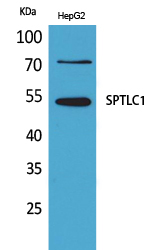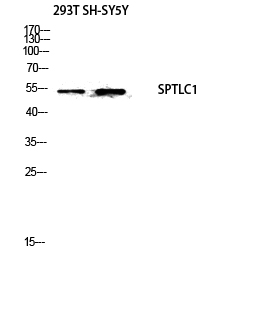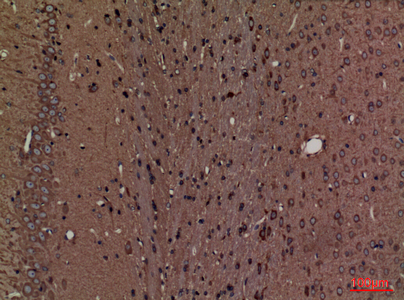SPTLC1 Polyclonal Antibody
- Catalog No.:YT5232
- Applications:WB;IHC;IF;ELISA
- Reactivity:Human;Mouse;Rat
- Target:
- SPTLC1
- Fields:
- >>Sphingolipid metabolism;>>Metabolic pathways;>>Sphingolipid signaling pathway
- Gene Name:
- SPTLC1
- Protein Name:
- Serine palmitoyltransferase 1
- Human Gene Id:
- 10558
- Human Swiss Prot No:
- O15269
- Mouse Gene Id:
- 268656
- Mouse Swiss Prot No:
- O35704
- Immunogen:
- Synthesized peptide derived from SPTLC1 . at AA range: 411-460
- Specificity:
- SPTLC1 Polyclonal Antibody detects endogenous levels of SPTLC1 protein.
- Formulation:
- Liquid in PBS containing 50% glycerol, 0.5% BSA and 0.02% sodium azide.
- Source:
- Polyclonal, Rabbit,IgG
- Dilution:
- WB 1:500 - 1:2000. IHC: 1:100-300 ELISA: 1:20000.. IF 1:50-200
- Purification:
- The antibody was affinity-purified from rabbit antiserum by affinity-chromatography using epitope-specific immunogen.
- Concentration:
- 1 mg/ml
- Storage Stability:
- -15°C to -25°C/1 year(Do not lower than -25°C)
- Other Name:
- SPTLC1;LCB1;Serine palmitoyltransferase 1;Long chain base biosynthesis protein 1;LCB 1;Serine-palmitoyl-CoA transferase 1;SPT 1;SPT1
- Observed Band(KD):
- 52kD
- Background:
- This gene encodes a member of the class-II pyridoxal-phosphate-dependent aminotransferase family. The encoded protein is the long chain base subunit 1 of serine palmitoyltransferase. Serine palmitoyltransferase converts L-serine and palmitoyl-CoA to 3-oxosphinganine with pyridoxal 5'-phosphate and is the key enzyme in sphingolipid biosynthesis. Mutations in this gene were identified in patients with hereditary sensory neuropathy type 1. Alternatively spliced variants encoding different isoforms have been identified. Pseudogenes of this gene have been defined on chromosomes 1, 6, 10, and 13. [provided by RefSeq, Jul 2013],
- Function:
- catalytic activity:Palmitoyl-CoA + L-serine = CoA + 3-dehydro-D-sphinganine + CO(2).,cofactor:Pyridoxal phosphate.,disease:Defects in SPTLC1 are the cause of hereditary sensory and autonomic neuropathy type 1 (HSAN1) [MIM:162400]. The hereditary sensory and autonomic neuropathies are a genetically and clinically heterogeneous group of disorders characterized by degeneration of dorsal root and autonomic ganglion cells, and by sensory and/or autonomic abnormalities. HSAN1 is an autosomal dominant axonal neuropathy with onset in the second or third decades. Initial symptoms are loss of pain, touch, heat, and cold sensation over the feet, followed by distal muscle wasting and weakness. Loss of pain sensation leads to chronic skin ulcers and distal amputations.,pathway:Lipid metabolism; sphingolipid metabolism.,similarity:Belongs to the class-II pyridoxal-phosphate-dependent aminotransferase
- Subcellular Location:
- Endoplasmic reticulum membrane ; Single-pass membrane protein .
- Expression:
- Widely expressed. Not detected in small intestine.
- June 19-2018
- WESTERN IMMUNOBLOTTING PROTOCOL
- June 19-2018
- IMMUNOHISTOCHEMISTRY-PARAFFIN PROTOCOL
- June 19-2018
- IMMUNOFLUORESCENCE PROTOCOL
- September 08-2020
- FLOW-CYTOMEYRT-PROTOCOL
- May 20-2022
- Cell-Based ELISA│解您多样本WB检测之困扰
- July 13-2018
- CELL-BASED-ELISA-PROTOCOL-FOR-ACETYL-PROTEIN
- July 13-2018
- CELL-BASED-ELISA-PROTOCOL-FOR-PHOSPHO-PROTEIN
- July 13-2018
- Antibody-FAQs
- Products Images

- Western Blot analysis of HepG2 cells using SPTLC1 Polyclonal Antibody. Antibody was diluted at 1:500. Secondary antibody(catalog#:RS0002) was diluted at 1:20000

- Western blot analysis of 293T SH-SY5Y lysis using SPTLC1 antibody. Antibody was diluted at 1:500. Secondary antibody(catalog#:RS0002) was diluted at 1:20000

- Immunohistochemical analysis of paraffin-embedded rat-brain, antibody was diluted at 1:100



